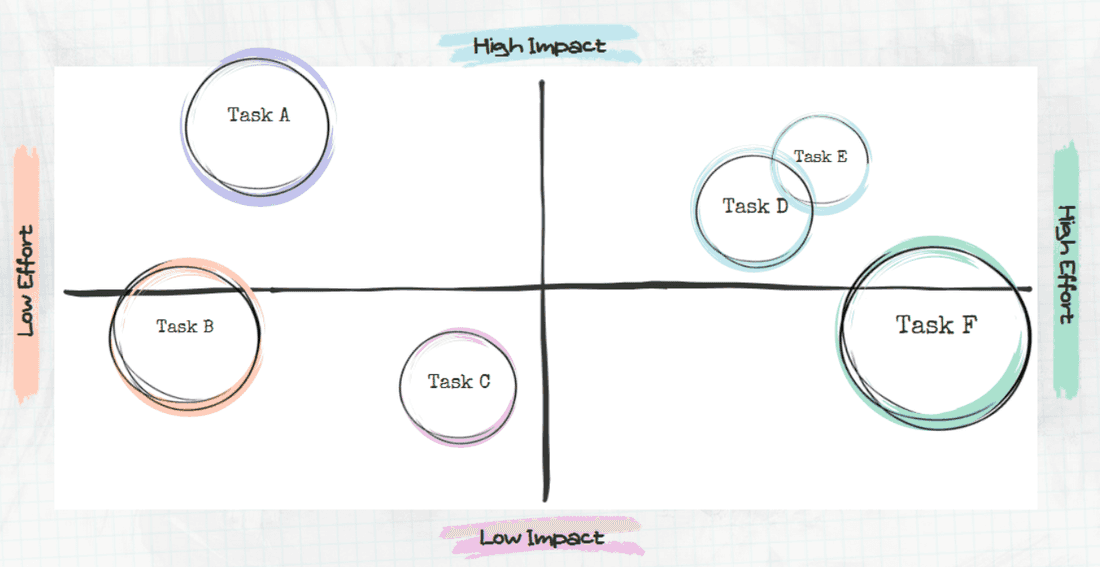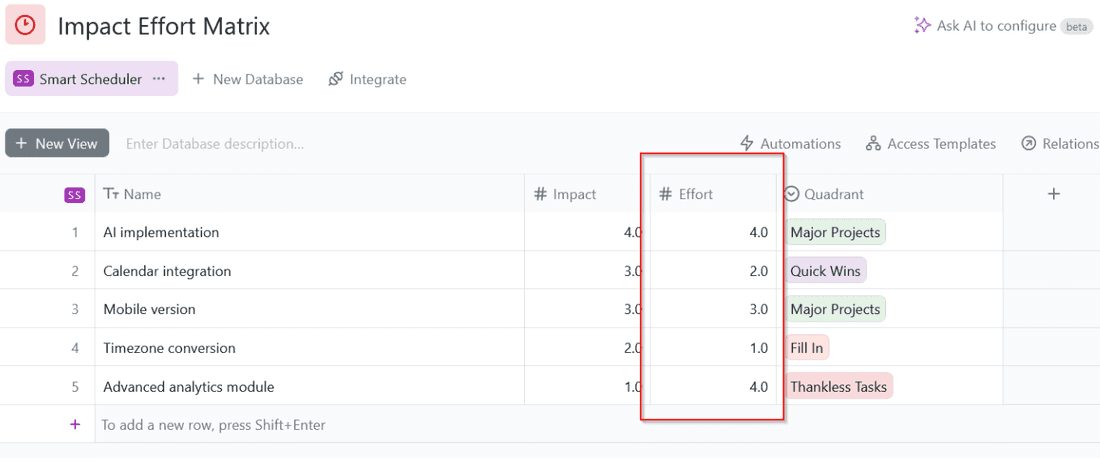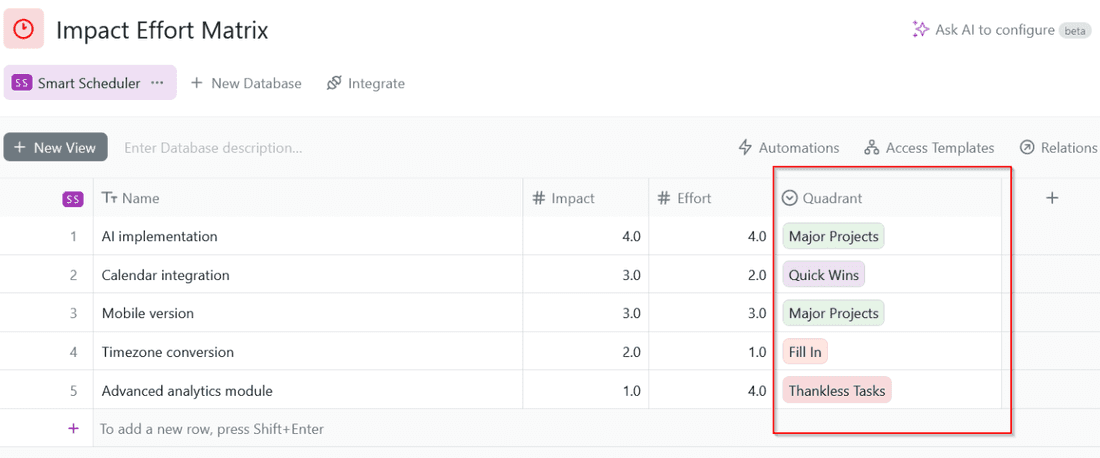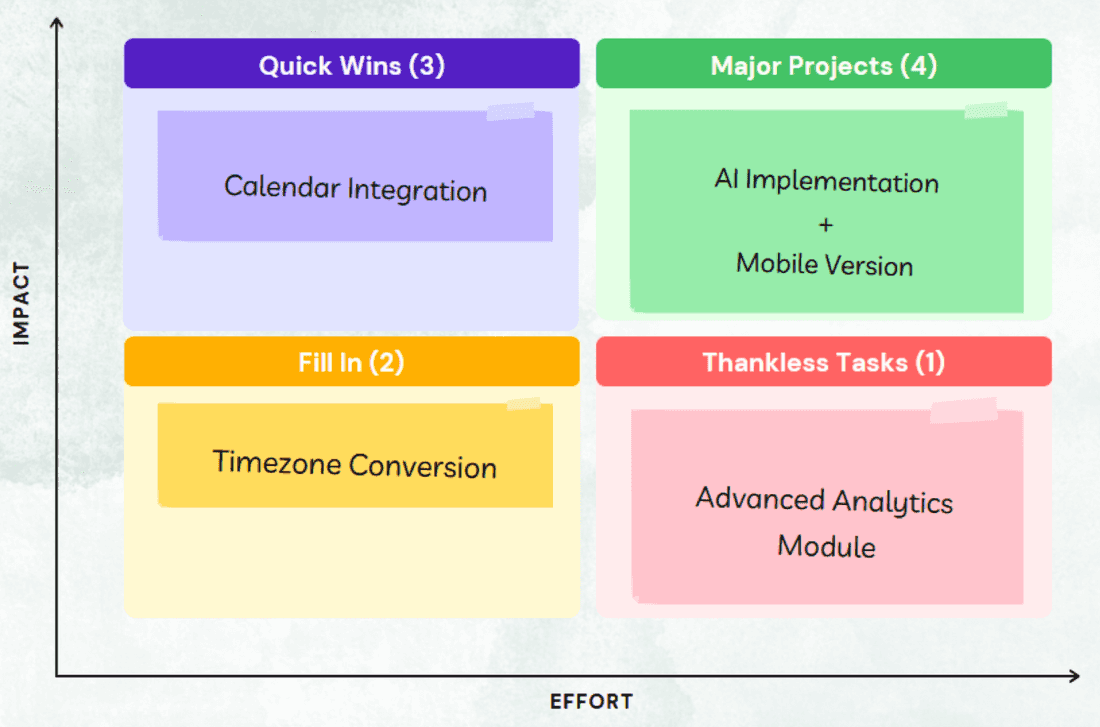Impact Effort Matrix: What It Is & How to Use It Correctly
As product managers, your time is the currency you trade in. So when it’s decision time, you need something that cuts through the noise without dumbing down your product’s complexities.
Enter the impact effort matrix: a no-nonsense approach to prioritization that sizes up potential bang-for-buck against what it’ll take to get there. What you’re going to get from this read:
- A clear grasp of the impact effort matrix
- How to break down its four quadrants
- Insights on timing and application for optimal use
- The standout advantages of weaving this matrix into your product management routine
What is an Impact Effort Matrix?
The impact-effort matrix is a simple tool used to evaluate the impact and effort required for a given task. This helps you identify which tasks are likely to have the biggest impact and which ones will require the most effort.
Think of the impact effort matrix as your trusty sidekick in the world of product management when you’re swamped with tasks and need to figure out what to tackle first.
It lays out all your options on a simple 2x2 grid that even a sleep-deprived intern could understand at 3 AM.
On one axis, you’ve got ‘impact,’ which is essentially how much bang for your buck each task will give you.
Then there’s ‘effort’ on the other axis—how many cups of coffee will it take from your team to get this done? Time, budget, and staff; it sizes up everything.
Understanding the 4 Quadrants of an Impact Effort Matrix

An impact effort matrix sorts tasks into categories that mix up how much they’ll change the game against what it takes to do them. The goal for product managers is figuring out where to best spend their time and energy. Let’s lay out each quadrant:
High Impact, Low Effort
Fast wins: These gems in your strategy bring significant benefits without eating up a lot of resources or time – like sending a quick email to lock in a contract, or submitting something five minutes before the deadline rather than after.
High Impact, High Effort
Big projects: These can be game-changers for your product, but prepare to buckle down with lots of hours and resources spent. Website revamps and designing a new product line are examples of this.
Low Impact, Low Effort
Easy Tasks: Tiny fix-ups fit in this category. They won’t change the world but will free up time for high-impact jobs. If left for too long, easy tasks quickly become frustrating chores.
Low Result, Big Input
To Be Avoided: These are the projects we all dread – the ones that gobble resources like there’s no tomorrow yet barely move the needle. For example, spending hours writing and sending sales emails that haven’t been optimized or looked at by a professional copywriter; they are unlikely to make you any sales but will chew up hours of your valuable time!
When to Use an Impact Effort Matrix?
All right, let’s talk about when to pull out the Impact Effort Matrix from your toolbox. It’s not something you toss around like confetti at every problem that pops up. But it does come in handy when the stakes are high and you’ve got to make some sharp decisions that align with those grand plans of yours.
- Got a Product Backlog? When there’s an Everest-sized mountain of possible features or tasks staring back at you, use this matrix to sift through what’s gold and what can wait.
- Roadmaps Need Tweaking? If you’re trying to get a clear picture of how your product should shape up over time without getting lost in ‘what-if’ land, this matrix is like a GPS for prioritizing potential impacts against efforts needed.
- Big-Picture Planning Getting Hairy?** **In meetings where everyone’s throwing their two cents on where the ship should steer next, the Impact Effort Matrix acts as both referee and navigator.
- Juggling Resources Like A Circus Act? When resources are tighter than jeans after Thanksgiving dinner, yet various projects are on the go, the matrix helps avoid burnout and maximize output.
Deploying the impact effort matrix during these scenarios ensures every move made is smart and feasible.
How to Create an Impact Effort Matrix?
Laying out an impact effort matrix is like giving product managers a pair of glasses to view which projects deserve their immediate attention. They get clarity on what’s going to make the biggest splash with the least amount of sweat.
We’ll roll through this prioritization process using Fibery and our hypothetical digital tool, “Smart Scheduler,” crafted for syncing up global teams without breaking a sweat.
Step 1: List Tasks
For Smart Scheduler, the tasks might include:
- Implement AI to suggest optimal meeting times based on user availability
- Integrate with existing calendar platforms (Google Calendar, Outlook)
- Develop a mobile version of the app
- Add a feature for automatic timezone conversion
- Create an advanced analytics module for user behavior patterns
Step 2: Rate Impact

Each task is assessed for its potential impact on user satisfaction and business outcomes:
- AI implementation: Very High impact (4), as it directly enhances functionality and user experience
- Calendar integration: High impact (3), crucial for usability and app adoption
- Mobile version: High impact (3), increases accessibility and user engagement
- Timezone conversion: Medium impact (2), improves user convenience but not critical
- Advanced analytics module: Low impact (1), provides detailed data but may not directly influence user experience or adoption
Step 3: Rate Effort

Estimate the effort required for each task considering time, costs, and technical complexity:
- AI implementation: Very High effort (4) due to the need for advanced programming and algorithm development.
- Calendar integration: Medium effort (2), involves API integration and testing.
- Mobile version: High effort (3), requires adapting the interface and functionality for mobile platforms.
- Timezone conversion: Low effort (1), relatively simple feature to implement.
- Advanced analytics module: Very High effort (4), involves complex data processing and integration but offers limited user-facing value.
Step 4: Plot on the Matrix

Position each task on the matrix:
- AI Implementation: High Impact, High Effort (Major Project)
- Calendar Integration: High Impact, Medium Effort (Quick Win, considering its crucial role and moderate difficulty)
- Mobile Version: High Impact, High Effort (Major Project)
- Timezone Conversion: Medium Impact, Low Effort (Fill In)
- Advanced Analytics Module: Low Impact, High Effort (Thankless Task)
Step 5: Analyze & Decide

With the matrix plotted, determine the prioritization:
- Quick Wins like the Calendar Integration should be prioritized to quickly boost user adoption with reasonable resource use.
- Major Projects like AI Implementation and Mobile Version development require careful planning and significant resources but are essential for the long-term success of the app.
- Fill Ins such as Timezone Conversion can be handled in smaller development windows or when there are available resources, adding value without major resource allocation.
- Thankless Tasks like the Advanced Analytics Module might need reconsideration or re-scoping unless they align more closely with strategic goals.
5 Benefits of Using an Impact/Effort Matrix
Breaking out the impact/effort matrix is a game changer for keeping projects on track and your team in sync. Let’s walk through what it does for you:
- Clear Prioritization: It’s like getting glasses for your project management vision – everything becomes crystal clear about where to put your energy.
- Strategic Alignment: It makes sure everyone’s rowing in the same direction, towards goals that actually matter to the business’s big picture.
- Team Alignment: Think of it as the ultimate peacemaker – it helps everyone agree on what matters most, avoiding those awkward standoffs about which tasks get top billing.
- Efficiency: Say goodbye to endless debates during meetings; this tool cuts right through indecision, making choices faster and smarter.
- Adaptability: The best part? As things change - because they always do - this matrix rolls with the punches, so you can adjust without derailment.
Simple as that! A straightforward approach that keeps teams sharp and strategies tighter than ever before - no frills needed.
Conclusion
The impact effort matrix is far from just another item in your toolkit. It’s a critical asset for navigating the complex terrain of product management.
Harness this matrix right, and you can align your team’s actions with purpose, making sure every ounce of energy spent pushes your product forward.
Kick off with low-hanging fruit to build up some steam, approach big initiatives with precision planning, and avoid those pesky tasks that drain resources without giving much back. Your product’s progress stands to benefit.
Eager for more seasoned pointers straight from the trenches? The Fibery blog has got you covered with insights penned by PMs who’ve been through it all. You’ll find an arsenal of tools tailored just for someone like you.
Psst... Wanna try Fibery? 👀
Infinitely flexible product discovery & development platform.